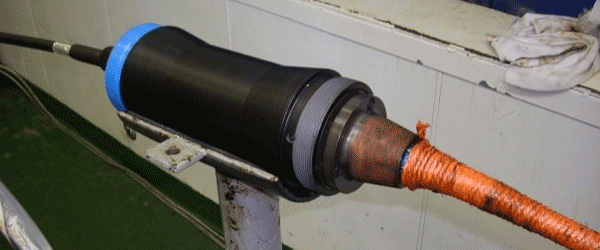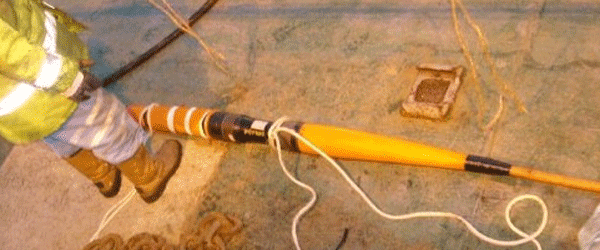Maintenance / Repair Operations
Submarine cables are very reliable, however, there are occasions when a repair to a cable becomes necessary.
Cable faults are caused by many events, both man-made and natural. In water depths greater than 1,000 metres faults are almost always caused by natural events such as underwater seismic activity, underwater landslides, current abrasion etc. In water depths less than 200 metres, faults are nearly always caused by man-made activities such as fishing and anchoring.
Around 70% of all cable faults are caused by fishing and anchoring activities and about 12% are caused by natural hazards, e.g. current abrasion or earthquakes.
When it becomes necessary to repair a cable, a cableship needs to be mobilised. Cableships are placed at strategic locations worldwide and are on 24 hour standby to carry out any repairs.
Cable systems are monitored constantly so when a system becomes faulty, it is known immediately. The staff in the cable stations at each end of the cable system then commences a series of tests to locate the fault. Once the fault location is known, this location is passed onto the cableship so it can make final plans for the repair.
The cableship will load the necessary spare cable and subsea plant required to carry out the repair. It will then sail to the fault location.
Once the cableship reaches the repair site, it will commence operations to recover the cable. The ship grapples for the cable using a large cutting grapnel (a hook), towing it along the seabed until it catches the cable. The cable is then raised off the seabed and cut. In buried sections of cable, an ROV might also be used to locate the cable and cut it on the seabed.
| Repair Operations Video |
|---|
Once the cable is cut, the grapnel is recovered to the cableship and replaced with a holding grapnel. This grapnel is then lowered to the seabed on a rope and towed along the seabed until one end of the cut cable is engaged/caught. The cable is then raised to the surface and recovered on board the cableship. The cable is then tested and any damaged sections removed. The cable is sealed to protect it from seawater ingress and lowered back to the seabed and buoyed off.
This recovery process is then repeated for the other cable end. Once all damaged cable has been removed and the original fault identified and cut out, the cable is jointed to a section of spare cable on board, sufficient in length to replace the damaged section which has been cut out. This cable is then paid out back to the cable which had been previously buoyed off. The buoy and other cable end is recovered back to the cableship and following tests to ensure there are no further faults, the two ends are then jointed together. This is called the final splice. The final splice is then lowered back to the seabed and final tests made to ensure the cable is working correctly. Where the repair has been made in a buried section of cable, the cable is reburied by means of an ROV, water jetting the cable back into the seabed to a target burial depth equivalent to that when the cable was originally laid. A repair operation may take many days to complete.
The final splice represents a further hazard to fishing gear since the final splice is essentially a bight of wire leading from the seabed to the ship. This is held onboard by rope stoppers, then the procedure is simply to slip both stoppers and lower the bight of cable back onto the seabed. Cable burial of this section is often not completely successful due to the sharp turns in the cable and poor visibility conditions and therefore avoidance of final splices is highly recommended.
Final Splice Bights are laid on the seabed at right angles to cable line. The crown of the bight may be up to 2 x water depth from chartered cable line.
| The process of jointing a cable |
|---|
 |
 |
 |
Disclaimer
TO DOWNLOAD THIS FILE, YOU MUST AGREE TO THE TERMS AND CONDITIONS "TERMS" NOTED AT THE FOOT OF THIS WEBSITE WHICH APPLY TO YOUR USE OF THIS WEBSITE AND TO USE OF THE FILE YOU HAVE CLICKED TO DOWNLOAD. IF YOU DO NOT AGREE TO THE TERMS, YOU WILL NOT BE ABLE TO DOWNLOAD THE FILE AND YOU SHOULD NOT USE THIS WEBSITE. TO CONFIRM YOUR ACCEPTANCE OF THE TERMS AND TO COMMENCE THE DOWNLOAD OF THE FILE, PLEASE CLICK THE "DOWNLOAD" CHECK BOX. IF YOU DO NOT AGREE TO THE TERMS, PLEASE CLICK THE "CANCEL" BUTTON. YOUR ATTENTION IS DRAWN TO CONDITION 3 NOTED BELOW WHICH FORMS PART OF THE TERMS IN RELATION TO OUR LIABILITY TO YOU.
Agree and download Cancel




